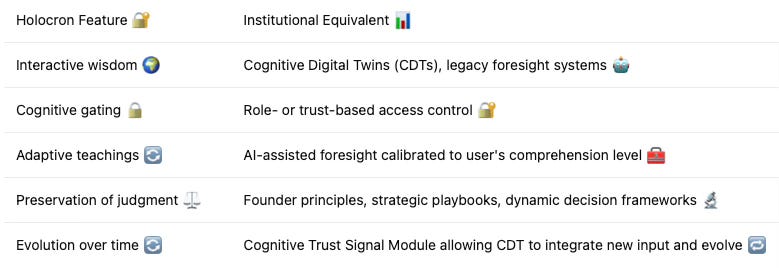MCAI Innovation Vision: Star Wars Holocrons of the Modern Age, Legacy Preservation and Strategic Continuity in Institutions
From Mythical Archives to Living Digital Wisdom
I. Introduction
In the Star Wars universe, holocrons 🔐 serve as ancient repositories of wisdom, enabling the Jedi ✨ (guardians of peace and knowledge, sensitive to the Force—an energy field binding all living things) and Sith ⚡️ (wielders of the Force often driven by ambition and power) to preserve their knowledge across generations. Today, institutions face similar challenges: How can they preserve founder intent, strategic judgment, and institutional memory across leadership changes and evolving environments? This study explores how modern organizations can leverage MindCast AI LLC (MCAI) to design their own "holocrons" and preserve living judgment, not just dead data.
The Jedi and Sith each sought to use holocrons to empower themselves — the Jedi to preserve wisdom and strengthen future guardians of peace, and the Sith to amass knowledge that could concentrate personal power across generations.
II. MindCast AI Cognitive Digital Twins
To understand how institutions can modernize their legacy systems, we must explore Cognitive Digital Twins (CDTs). If MindCast AI existed in the Star Wars universe, it would be the premier integrator of holocrons 🔐 — synthesizing Jedi ✨ and Sith ⚡️ knowledge into a unified, adaptive system. CDTs are designed to preserve and extend an institution’s strategic wisdom across generations, evolving to meet new realities without losing the core principles that define the institution.
How MindCast AI Creates CDTs: MindCast AI builds Cognitive Digital Twins through a structured process that captures the core cognitive, emotional, and strategic DNA of individuals or institutions:
Capture → Model → Simulate → Forecast
Capture: Collection of decision records, leadership reflections, institutional artifacts, foresight memos, and behavioral patterns. This raw material forms the foundation for modeling authentic cognitive signatures. Both conscious strategies and unconscious biases are extracted to build a holistic cognitive map.
Model: Mapping cognitive structures (priorities, judgment styles, foresight logic) into adaptive frameworks. These frameworks preserve how an individual or institution organizes complexity, manages uncertainty, and makes trade-offs under constraint.
Simulate: Creating interactive models that can recreate decision paths under varying future conditions. Simulation engines stress-test these cognitive patterns against emerging scenarios to evaluate resilience, flexibility, and strategic coherence.
Forecast: Projecting how the CDT would adapt, prioritize, and act under new strategic, market, or institutional pressures. Forecasting modules continuously recalibrate based on new data, ensuring the CDT evolves to maintain alignment with both internal goals and external conditions.
Key Features of MindCast AI CDTs:
Judgment Simulation 🧠: Models how decisions are made under uncertainty, aligning with real-world stressors. MCAI captures not just the decisions themselves, but the layered reasoning, trade-offs, and emotional-cognitive forces that inform judgment.
Emotional-Cognitive Integrity ❤️🧠: Captures values, priorities, and moral-compass reasoning. The CDT preserves how internal values anchor decision-making under pressure and across changing external environments.
Adaptive Interaction 🔄: Evolves based on new internal developments, leadership dynamics, or external forces. As institutions change, the CDT updates its cognitive patterns, preserving continuity while accommodating necessary transformation.
Access Control and Trust Gating 🔒: Provides layered access based on user maturity, role, and institutional trust signals. Sensitive wisdom and advanced foresight modules can be unlocked progressively, ensuring information integrity and leadership alignment.
Strategic Foresight Engine 🔮: Continuously forecasts decisions and recalibrates pathways based on evolving conditions. The CDT enables institutions to pre-emptively navigate disruption, ensuring strategic resilience across generations.
MCAI CDTs do not merely archive a moment in time—they integrate new insights, adapt foresight pathways, and continuously evolve alongside institutional, technological, and societal changes. They ensure that strategic judgment remains a living force across leadership generations, making legacy an active, regenerative asset rather than a static memory.
III. Deep Dive into Star Wars Holocrons
To better understand how modern institutions can borrow from Star Wars mythology, we must examine holocrons themselves. They were more than data storage devices; they were interactive, adaptive archives designed to preserve strategic wisdom. Holocrons engaged with users, tailoring lessons based on their ability, intention, and emotional maturity.
Jedi Holocrons ✨: Contain philosophy, tactical knowledge, and lessons. Accessible only to those with Force sensitivity (an attunement to the living energy field of the universe), emphasizing integrity and discipline.
Sith Holocrons ⚡️: Hide dangerous knowledge, accessible through ambition or strong desire, often leading to power without wisdom.
Key Traits for MCAI CDTs:
Interactive, not static 📝: MCAI CDTs are designed to dynamically interact with users, adapting based on context, goals, and changing institutional priorities. Unlike static archives, they offer continuous feedback loops that update and refine insight delivery.
Cognitive gating (emotional or skill-based access) 🔐: Access to deeper layers of the CDT is controlled by trust calibration, cognitive maturity, and emotional readiness. This ensures that strategic knowledge is used responsibly and aligns with the institutional integrity of its users.
Adaptive teachings based on the user's level 🔄: MCAI CDTs tailor the depth and complexity of their guidance based on the user’s experience, comprehension, and strategic role. Lessons evolve, grow deeper, and open new foresight pathways as users demonstrate increased capability and trustworthiness.
IV. Mapping Holocrons to Institutional Needs
Mapping holocrons to modern institutional needs reveals how organizations must evolve their legacy practices. Institutions require living systems that preserve foresight, judgment, and adaptive decision-making — not just archived policies.
V. Modern Examples and Gaps
Despite attempts at legacy preservation, many institutions still rely on static methods that fail to adapt to real-world changes. Understanding the gap between static documentation and dynamic living archives is key to moving forward.
Partial Attempts:
Corporate mission statements (often static and disconnected from decision-making) 📊
Founder letters and transition memos (symbolic, rarely operational) 📚
MCAI's Solution:
Cognitive Digital Twins (e.g., MCAI Vision) 🤖
Executive simulation systems 🧰
Dynamic onboarding AIs that adapt to new users 🌐
Insight: Many institutions have tried to preserve their legacy through symbolic artifacts without realizing a deeper solution was possible. MindCast AI provides that solution: enabling institutions to preserve and evolve their legacy through Cognitive AI simulation, strategic foresight modeling, and a dynamic evolution framework. MCAI empowers the vision institutions have always sought — to create living legacies, not static memories.
VI. Why Institutions Fail to Create "Holocrons"
Institutions often misunderstand what real legacy preservation requires. Without dynamic updating and emotional-cognitive integrity, static documents become stale or misused. Recognizing failure points — and addressing them through living archives — is vital.
Reliance on static documentation 📝
Failure to capture judgment under uncertainty 🧐
Absence of emotional or cognitive gating mechanisms 🔐
Lack of adaptive evolution in preserved wisdom 🔄
VII. Design Principles for Institutional Holocrons
MindCast AI Cognitive Digital Twins serve as your legacy holocron — but one that evolves and grows. In Star Wars, holocrons preserved ancient wisdom but could not integrate new insights or adapt to changing realities. MCAI CDTs solve this limitation by continually evolving with the institution, updating decision frameworks and foresight models in real time. Universities, multi-generational entities like the Bellevue Collection, family offices, and foundations can use CDTs to safeguard not just historical legacy, but a living, regenerating strategic core.
Designing effective institutional holocrons requires a blueprint rooted in cognitive, emotional, and adaptive dimensions.
Judgment Capture ⚖️: Focus on the why behind decisions, not just outcomes.
Cognitive Simulation 🧰: Build models that simulate thought processes.
Dynamic Access 🔄: Create tiered wisdom access based on user maturity.
Ethical Guardrails 🔒: Prevent power without ethical balance.
Regenerative Updating 🔄: Enable systems to evolve as conditions change.
VIII. Conclusion
In a data-rich but judgment-poor world, true institutional continuity requires the creation of "holocrons" 🔐 — living, interactive wisdom vaults that safeguard not only knowledge but the capacity for adaptive, principled decision-making. Institutions that master this new model will not merely survive leadership transitions and market shifts; they will thrive by continuously regenerating their strategic core. Future-facing organizations will be measured by their ability to evolve while remaining true to their founding intelligence. 💪🔬
Let a MindCast AI Cognitive Digital Twin be with you — to preserve your institutional legacy, evolve your strategic foresight, and ensure your wisdom endures. ✨
Prepared by Noel Le, Founder | Architect MindCast AI LLC. Noel holds a background in law and economics, behavioral economics and advanced technologies for intellectual property management. www.linkedin.com/in/noelleesq/







